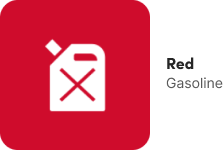Fuel Safety
Thousands of customers fill up at GetGo every day, which is why we make fuel safety our number one priority! It’s also why we expect customers to follow several simple guidelines while fueling their vehicles — and why we reserve the right to shut off pumps when we observe practices that might threaten your safety or the safety of others. We enforce these rules for the protection of all our customers and Team Members, and also to remain in compliance with flammable and combustible liquids laws respective to the states in which GetGo operates.
5 steps for fuel saftey
- Turn off your vehicle before pumping.
- Stay at the pump while using hold-open latches to fill up.
- No smoking near pumps! Gasoline is flammable and vapors are explosive.
- Remain outside vehicle while fueling to avoid vapor fires caused by static electricity.
- Do not double pump. The filling of multiple vehicles, or double pumping, poses a fire hazard.
Filling portable fuel containers
Warning: Improper filling creates a danger of fire! It is unlawful and dangerous to dispense gasoline into unapproved or improperly labeled containers.
- Place container on the ground to avoid possible static electricity ignition of fuel vapors.
- Never fill container in a vehicle, trunk, truck bed or trailer!
- Fill container slowly and never to the top — allow for vapor expansion.
- Only fill approved, properly labeled color-coded containers:
Gasoline Health & Safety Information
- Gasoline is extremely flammable and vapors are explosive.
- Never siphon gasoline by mouth — it is harmful or fatal if swallowed.
- Keep nozzle away from eyes and skin.
- Avoid breathing gasoline vapors for a long period of time.
- Use gasoline only as a motor fuel.
- Do not overfill or top off your gas tank.
Kerosene Safety
- Purchase only water-clear K-1 grade kerosene. GetGo sells only certified K-1 grade kerosene.
- Always store kerosene in a clearly marked, color-coded (blue) container designated exclusively for kerosene.
- Always refuel your heater outdoors, at a distance from combustible materials. Make sure the heater is turned off and has been allowed to cool.
- Do not overfill your kerosene container or heater.
- Only operate your kerosene heater in a ventilated area.
- Make sure the wick of your heater is clean and in good condition before using.
Gasoline safety doesn’t end at the pump
For your safety, practice these gasoline storage rules in your home:
- Check with local or state agencies for fire codes regulating the amount of gasoline a homeowner may store, and the legal manner to do so.
- Store gasoline only in approved containers or tanks. Keep containers closed tightly and handle with care to avoid spillage.
- Store gasoline at room temperature, away from heat sources (the sun, a hot water heater, space heater or furnace) and at least 50 feet away from ignition sources, such as pilot lights.
- Do not smoke where gasoline is handled or stored.
- Allow engines and attachments to cool before fueling lawn mowers or other machinery.
- Store gasoline in a shed, garage or other building separate from your residence.
- Always keep gasoline out of reach of children.
- Always handle gasoline in well-ventilated areas, preferably outdoors.
- Do not mix gasoline in any amount with kerosene or diesel fuel.
- Never use gasoline in devices that run on kerosene.
- Absorb minor gasoline spills with sawdust, paper or rags.
- Never dispose of spilled gasoline or cleaning materials in your garbage, drains, toilets or sewers.
- Check with local agencies for proper collection and disposal procedures for larger spills.
Get informed
The fuel safety rules we follow at GetGo are consistent with industry and governmental standards for the safe handling of flammable and combustible liquids.
If you’re interested in learning more about the laws governing fuel safety where you live, you’ll find the following Web sites helpful:


